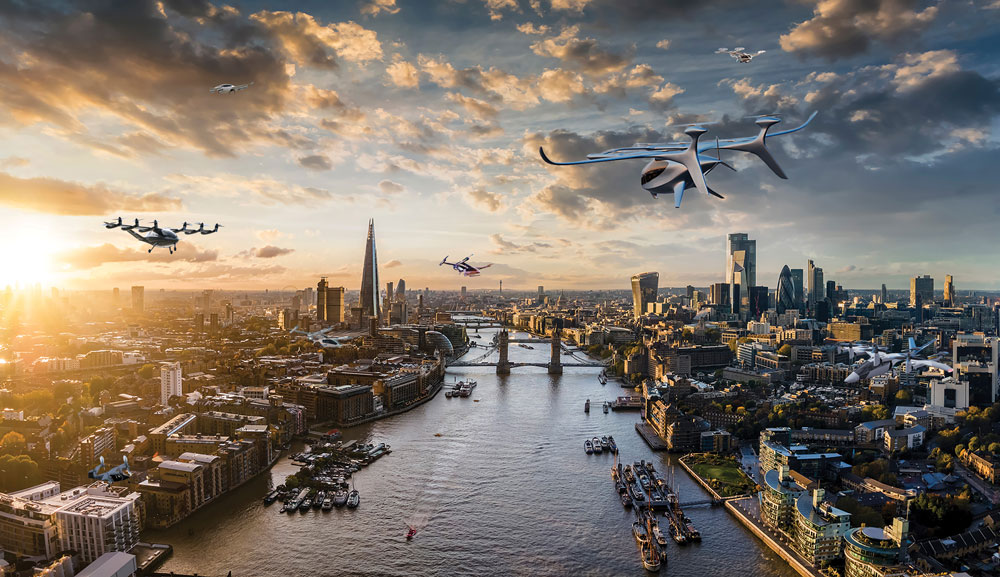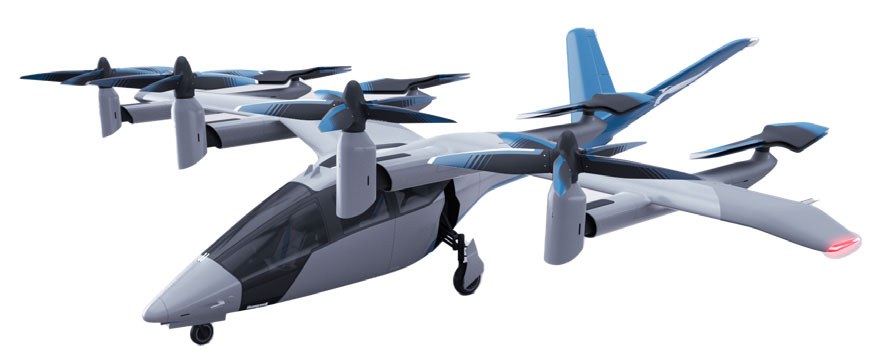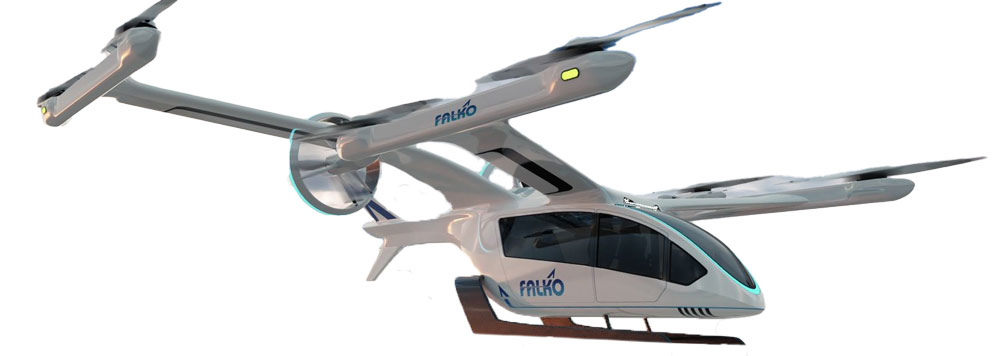GENERAL AVIATION Advanced aerial mobility
Hailing the future
Advanced urban air mobility should not be seen as niche VIP air taxis, but potentially a social good for all. GARY CUTTS, Director of the Future Flight Challenge at UK Research and Innovation (UKRI) and RAeS President-Elect KERISSA KHAN, MRAeS, Innovation Lead at the UKRI Future Flight Challenge provide insight into the opportunities.
 Archer, Falko, Helipass, Autoflight, Joby Aviation, Lilium, Eve, Vertical
Archer, Falko, Helipass, Autoflight, Joby Aviation, Lilium, Eve, VerticalThe concept of a new future aviation system continues to see growing support and engagement as it develops. While there are many elements to consider along this journey, the core focus should always remain on the benefits of better connecting people. As society changes, so new innovative concepts can be used to create a sustainable, convenient and technology-led service that goes further to meet evolving transport demands.
It is something to take seriously too. This is not simply a pipe dream of the future, but a credible, forward-thinking research and planning strategy that is backed by government and industry alike.
A number of significant stakeholders from across the sector are already playing a key role, with many most recently coming together earlier this year at the Global Urban and Advanced Air Summit at Farnborough, and also for the publication of the Eve Urban Air Mobility Concept of Operations (CONOPS) for the London Environment alongside the UK Civil Aviation Authority (CAA).
Of course, with any new and changing industry there are hurdles to overcome and a need to help bring opposing views on board. This piece aims to focus on what is possible when it comes to an effective introduction of new electric vertical take-off and landing (eVTOL) vehicles in the UK, and the benefits that could be seen by embracing these vehicles for particular use cases and opportunities in the future.
What are the hurdles and perceptions?
Before we come on to opportunities, it is useful to first see what needs to be overcome. It is perhaps important at this point to stress that those involved in the concepts for the future aviation system are not trying to run before they can walk. This is not about far-fetched drawing board ideas you would see in sci-fi or novel private executive flight solutions for the rich – it is about developing effective connectivity solutions for people and communities who need them.
THESE EVTOL VEHICLES OFFER A TRANSPORT SERVICE THAT IS NOT RELIANT ON THE CONSTRUCTION OF A LARGER ROAD NETWORK, AND THE INFRASTRUCTURE THAT COMES WITH IT, IN ORDER TO ACHIEVE ITS GOALS OF CONNECTIVITY
In wider commentary on the subject, there is a lot of initial focus on eVTOL vehicles making short hops and inner-city trips. However, such use cases, while potentially important, will have to be proven to make financial, time and logistical sense, and will be dependent on public demand. Instead, the focus has started to shift towards providing an alternative transport solution for longer journeys and mid-range commutes, as well as improving travel and transport options for those in rural and isolated areas across the UK.
Another hurdle is regulation. This will always be a challenge but that’s no bad thing if the end result is improved industry and public confidence in the new concepts and a more effective and professional industry developing as a result. That is because there is so much to focus on regulatory terms. Passenger safety will rightly take ultimate priority but there are a number of elements, such as certification, licensing, telecommunications, information security, airspace regulation and vehicle testing that will also need to be right before the vehicles take to the skies – and this can take time.
Real progress, though, has already been made in this regard and, as outlined later, more is on the horizon.
The social benefits
Focusing heavily on flight costs and tricky industry logistics also does not take into account one of the key elements to the potential success of the future aviation concept – the social benefits that a revolutionised airspace could bring.

The new passenger experience that could be achieved will not just be about saving time but will bring a service to people that is far more convenient, connected, comfortable and sustainable. Again, this is not a pie-in-the-sky plan for personal vertiports in gardens but a research-led vision for a collaborative transport ecosystem that incorporates different modes of transport to complete the overall journey. A point-to-point electric vehicle service, that offers connections from home to a destination through a combination of electric taxis and eVTOL aircraft, can provide a seamless and accessible solution for many across society.
Having this new solution could mean so much in different ways to different groups of people. For some, it could mean faster and safer journeys for important medical care from their remote location, while for others it could mean the difference between being able to access better jobs and education from their rural setting. We also cannot dismiss the importance of simply connecting people with other people too, as well as giving them better transport access to a range of amenities that could improve their quality of life.
The uptake of this way to travel by some would also bring knockon benefits for others. Reduced congestion would save time and cost for the many people and businesses who require continued use of the road network, while eVTOL emergency services could also provide life-changing improvements in response times.
It is the environmental benefits that could be the backbone for support of the new aviation system. These eVTOL vehicles offer a transport service that is not reliant on the construction of a larger road network, and the infrastructure that comes with it, in order to achieve its goals of connectivity. Avoiding the need to remove natural habitats, green belt land and tree populations in order to connect rural communities and improve commuter routes should not be seen as a ‘nice-to-have’, but as a foundation for solving transport issues in a forward-thinking way.
Complementing, not displacing, existing transport and technology
Within all of the plans being undertaken, it is also important to recognise that there is a clear distinction between traditional aerospace and these new technologies. The eVTOL vehicle market will never challenge large long-haul airlines, but their support in the development of technology, infrastructure, procedures and data is essential to the success of the future flight industry.
 In April, Urban Air Port opened its first trial vertiport in Coventry to the public to gauge interest in the concept. The company plans to open over 200 vertiports worldwide.
In April, Urban Air Port opened its first trial vertiport in Coventry to the public to gauge interest in the concept. The company plans to open over 200 vertiports worldwide.
Instead, it is small aircraft that will be the focus of the plans to integrate into the airspace and provide point-to-point air transport services to smaller towns that cannot today justify airport infrastructure. Smaller eVTOL vehicles that are reliable and inexpensive to operate can serve a useful purpose in the domestic flight sector and as an alternative to other modes of medium-distance transport. It is evident that these vehicles will inevitably become part of an expanded but green aviation industry and this is surely evidenced by the array of talent and experienced industry professionals who have moved across to the eVTOL vehicle space in the UK and beyond.
It is also important to clarify that the introduction of eVTOL vehicles will not create a rush on natural resources for battery creation – and in turn, competition with electric car manufacturers. The scale of demand for batteries for eVTOL vehicles will be substantially smaller than that from the automotive sector and it would be hard to imagine the two becoming an ‘either/or’ issue.
The importance of backing innovation
The sector is still evolving. UK Research and Innovation’s (UKRI) Future Flight Roadmap and Vision outlines the progress required from across a number of elements of the industry right up to 2030 – and most likely beyond, to position the UK as a world leader in future flight services, consultancy, technology, international partnerships and academic liaison. There is no harm in saying that some parts of the future aviation system are at the start of their development, and that there are challenges ahead to overcome. However, through collaboration and support for innovative new concepts, these are being addressed.
THE PLANS AND ROADMAPS IN PLACE, BACKED BY GOVERNMENT FUNDING AND INDUSTRY SUPPORT, ARE NOT SIMPLY AN AMBITION BUT A BELIEF IN A BETTER AVIATION FUTURE
Plus, it is important to also consider that much of the work being undertaken now will form the building blocks for other forms of new aviation in the future too. The eVTOL segment can prototype all aspects of electric flight and the required transformation in air traffic management can be applied to commercial air transport to optimise flights and reduce emissions.
It is here that the UK can play a significant role. Currently, the UK is recognised as a leading nation, in terms of the supply chain for the development and deployment of these technologies. Through the support of UKRI and other funding bodies, the UK is also providing substantial investment into areas, like energy, battery power, digitalisation, robotics and manufacturing, as well as efforts to connect remote regions.
We must remember it is not only the UK making progress. The European Union Aviation Safety Agency (EASA) has just recently published the first guidance for vertiport design across Europe. The aim is to improve standards of design and infrastructure by providing a framework for the construction of vertiports to serve eVTOL vehicles. This was another landmark moment, giving credibility not only to the concept itself, but also confirming that the eVTOL sector plans to work with lawmakers from the outset to create a high-quality and properly regulated industry.
Plenty to be positive about then
Inevitably, there will be bumps along the way and not every concept will be a success. All previous revolutions in aviation have started with no certainty of technical or commercial success but
the industry has been bold, learnt by experience and flourished. The industry will continue to adapt and survive as it moves from ideas to adoption in the coming years and experienced professionals will move with it.
So, while pessimism exists, those involved in the development of the future aviation system are countering this with realistic and effective strategies for research, testing, production and adoption. The plans and roadmaps in place, backed by government funding and industry support, are not simply an ambition but a belief in a better aviation future.
Examples of progress
It is important to realise that this is not all just at the ideas stage too. In some cases, prototypes of these eVTOL aircraft have already been built, flight tests have been conducted and moves towards certification have gathered pace – not least between the CAA and US Federal Aviation Administration, who have committed to bilateral discussions to facilitate certification, licensing and operational progress.
 Falko
FalkoAs part of the Future Flight Challenge, a number of projects are already under way that are helping to develop vehicle systems capabilities and supporting physical, digital, energy and airspace infrastructure to move the needle forwards on the sector. For example, Retroflight-Alpha is focused on the development of the electric charging infrastructure that eVTOL vehicles require for their operation, while another project, Fly2Plan, is looking to progress the digital infrastructure needed to support the integration of eVTOL operations into the airspace.
Led by Heathrow Airport, alongside Altitude Angel, the National Air Traffic Services (NATS) and other technology companies, the digital platform will provide important elements, including flight data, aeronautical information and weather information for eVTOL operators, air traffic controllers, UTM platform providers, ANSPs, airlines and airports.
As well as these, the Hydrogen Electric and Automated Regional Transportation (HEART) project is working on new technological solutions for an improved regional transport network, integrating hydrogen-powered light aircraft, eVTOLs and other forms of transport to provide mobility-as-a-service. In addition, the Urban Air Port concept is focused on the development and demonstration of a vertiport, the physical infrastructure that will be required to support eVTOL operation.
This will be the world’s first pop-up airport and its progress is testament to the collaboration between the partners, including Supernal and Coventry City Council. This is one example of how working alongside a progressive local authority demonstrates the appetite to explore how local areas can benefit from these new concepts.
More widely, the CONOPS undertaken by Eve is another welcome demonstration of how collaboration is making things happen. To have representatives from Heathrow and London City airports, a number of technology firms – including Skyports, Atech, Volocopter and Vertical Aerospace – as well as NATS and the CAA itself, is a landmark step towards the success of the eVTOL strategy. The consortium has identified key regulatory priorities, as well as securing direct stakeholder engagement feedback and computer simulation modelling. These will be important components for ensuring the CAA can effectively support the development of these vehicles and that the sector remains on track as it grows.
What does the future hold?
The projects above form part of a portfolio of 48 projects funded by Phase 2 of the UKRI Future Flight Challenge, which has been tasked with creating the future aviation system for eVTOLs and other future flight technologies. Phase 3 projects are set to begin later this year, with successful projects receiving £70m in total to develop and demonstrate integrated aviation systems and new vehicle technologies.
Beyond the funding itself, work across the sector is starting to move from the current development and simulation stage into real-world demonstrations. As these demonstrations progress over the next two years, an industrial focus for more commercial production will then take shape, before the concepts themselves are taken to new locations and integrated into communities to prove their viability as part of a new mobility service.
To achieve what it sets out to, collaboration will be key among a wide range of stakeholders who can help make this change to the aviation sector happen. It is not just about vehicle designers, a whole ecosystem needs to build upon the early success and work together to move these carefully constructed plans forwards to ensure the eVTOL concept gains the engagement, support and, ultimately, adoption it needs.
If successful, the benefits to many people and businesses across urban, rural and remote areas can be substantial.
 Archer, Falko, Helipass, Autoflight, Joby Aviation, Lilium, Eve, Vertical
Archer, Falko, Helipass, Autoflight, Joby Aviation, Lilium, Eve, Vertical

